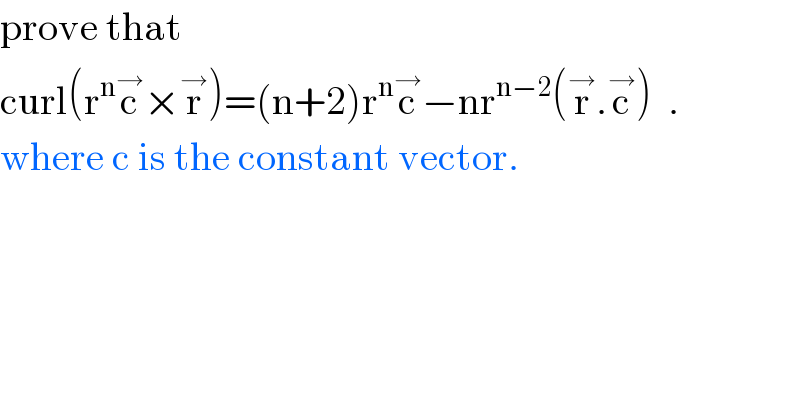
Question and Answers Forum
Question Number 85865 by subhankar10 last updated on 25/Mar/20

Answered by TANMAY PANACEA. last updated on 25/Mar/20
![r^→ =ix+jy+kz→r^2 =x^2 +y^2 +z^2 r^n =(x^2 +y^2 +z^2 )^(n/2) c^→ =ia+ib+kd curlA^→ =▽^→ ×A^→ (i(∂/∂x)+j(∂/∂y)+k(∂/∂z))×A^→ now ▽^→ ×(c^→ ×r^n r^→ ) =(▽^→ .r^n r^→ )c^→ −(▽^→ .c^→ )r^n r^→ =c^→ (i(∂/∂x)+j(∂/∂y)+k(∂/∂z)).(x^2 +y^2 +z^2 )^(n/2) (ix+jy+kz) =c^→ [(∂/∂x){x.(x^2 +y^2 +z^2 )^(n/2) }+(∂/∂y){y(x^2 +y^2 +z^2 )}+(∂/∂z){z(x^2 +y^2 +z^2 )}] calculation of (∂/∂x){x(x^2 +y^2 +z^2 )^(n/2) } =(x^2 +y^2 +z^2 )^(n/2) ×1+x×(n/2)(x^2 +y^2 +z^2 )^((n/2)−1) ×2x =r^n +x^2 ×n(r^2 )^((n/2)−1) =r^n +x^2 ×n×r^(n−2) adding three 3r^n +nr^(n−2) (x^2 +y^2 +z^2 ) =3r^n +nr^n =r^n (n+3) so answer is r^n (n+3)c^→ timorrow i shall solve in paper .=.. c^→ ×r^→ ∣i j k ∣ ∣a b d ∣ ∣x y z ∣ =i(bz−yd)−j(az−xd)+k(ay−bx) now ∣i j](Q85889.png)
| ||
Question and Answers Forum | ||
Question Number 85865 by subhankar10 last updated on 25/Mar/20 | ||
 | ||
Answered by TANMAY PANACEA. last updated on 25/Mar/20 | ||
![r^→ =ix+jy+kz→r^2 =x^2 +y^2 +z^2 r^n =(x^2 +y^2 +z^2 )^(n/2) c^→ =ia+ib+kd curlA^→ =▽^→ ×A^→ (i(∂/∂x)+j(∂/∂y)+k(∂/∂z))×A^→ now ▽^→ ×(c^→ ×r^n r^→ ) =(▽^→ .r^n r^→ )c^→ −(▽^→ .c^→ )r^n r^→ =c^→ (i(∂/∂x)+j(∂/∂y)+k(∂/∂z)).(x^2 +y^2 +z^2 )^(n/2) (ix+jy+kz) =c^→ [(∂/∂x){x.(x^2 +y^2 +z^2 )^(n/2) }+(∂/∂y){y(x^2 +y^2 +z^2 )}+(∂/∂z){z(x^2 +y^2 +z^2 )}] calculation of (∂/∂x){x(x^2 +y^2 +z^2 )^(n/2) } =(x^2 +y^2 +z^2 )^(n/2) ×1+x×(n/2)(x^2 +y^2 +z^2 )^((n/2)−1) ×2x =r^n +x^2 ×n(r^2 )^((n/2)−1) =r^n +x^2 ×n×r^(n−2) adding three 3r^n +nr^(n−2) (x^2 +y^2 +z^2 ) =3r^n +nr^n =r^n (n+3) so answer is r^n (n+3)c^→ timorrow i shall solve in paper .=.. c^→ ×r^→ ∣i j k ∣ ∣a b d ∣ ∣x y z ∣ =i(bz−yd)−j(az−xd)+k(ay−bx) now ∣i j](Q85889.png) | ||
| ||